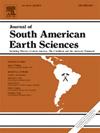巴西洪水预测:趋势、差距和方法观点综述
IF 1.7
4区 地球科学
Q3 GEOSCIENCES, MULTIDISCIPLINARY
引用次数: 0
摘要
随着气候变化和城市扩张加剧极端水文气象事件的频率和严重程度,洪水预测对于减轻极端水文气象事件的不利影响至关重要。本综述系统地综合了2012年至2024年间发表的科学文献,绘制了巴西洪水预测的方法趋势、区域差异和模式类型。分析显示,研究集中在南部和东南部,那里强大的数据基础设施支持采用物理、统计、机器学习和混合模型。相反,北部、东北部和中西部地区的代表性仍然严重不足。方法上的差距包括短期预测占主导地位,以及在长期模式中未充分利用气候和城市变量。为了应对这些挑战,我们主张扩大实时监测网络,整合多源数据,并推广混合和人工智能增强的预测技术。这些行动对于促进巴西各地的气候适应能力和公平的水文风险管理至关重要。本文章由计算机程序翻译,如有差异,请以英文原文为准。
Flood prediction in Brazil: A review of trends, gaps and methodological perspectives
Flood prediction is crucial in mitigating the adverse effects of extreme hydrometeorological events, as climate change and urban sprawl intensify their frequency and severity. This review systematically synthesizes scientific literature published between 2012 and 2024, mapping methodological trends, regional disparities, and model typologies in Brazilian flood forecasting. The analysis reveals a concentration of studies in the South and Southeast, where robust data infrastructures support the adoption of physical, statistical, machine learning, and hybrid models. Conversely, the North, Northeast, and Midwest regions remain critically underrepresented. Methodological gaps include a predominance of short-term forecasts and the underutilization of climatic and urban variables in long-term modeling. To address these challenges, we advocate for expanding real-time monitoring networks, integrating multisource data, and promoting hybrid and AI-enhanced forecasting techniques. These actions are essential for fostering climate resilience and equitable hydrological risk management across Brazil.
求助全文
通过发布文献求助,成功后即可免费获取论文全文。
去求助
来源期刊

Journal of South American Earth Sciences
地学-地球科学综合
CiteScore
3.70
自引率
22.20%
发文量
364
审稿时长
6-12 weeks
期刊介绍:
Papers must have a regional appeal and should present work of more than local significance. Research papers dealing with the regional geology of South American cratons and mobile belts, within the following research fields:
-Economic geology, metallogenesis and hydrocarbon genesis and reservoirs.
-Geophysics, geochemistry, volcanology, igneous and metamorphic petrology.
-Tectonics, neo- and seismotectonics and geodynamic modeling.
-Geomorphology, geological hazards, environmental geology, climate change in America and Antarctica, and soil research.
-Stratigraphy, sedimentology, structure and basin evolution.
-Paleontology, paleoecology, paleoclimatology and Quaternary geology.
New developments in already established regional projects and new initiatives dealing with the geology of the continent will be summarized and presented on a regular basis. Short notes, discussions, book reviews and conference and workshop reports will also be included when relevant.
 求助内容:
求助内容: 应助结果提醒方式:
应助结果提醒方式:


